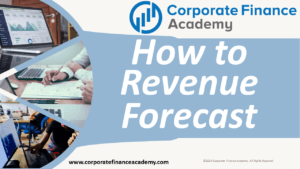
- Hello!
If you work in Financial Planning & Analysis or Corporate Finance, you most likely will have to develop a revenue forecast at some point. the only thing you can be certain of when doing this forecast is that it will be wrong!
The question is, how close can you get (with a reasonable level of effort)?
In my 20 years in finance across multiple business models and industries, I have seen super complicated revenue forecasting methods, minimal effort forecasts, highly detailed forecasts, and forecasts that are basically educated guesses with no data behind them.
The reality is, forecasting is usually quite important (how important depends on your business model, it’s flexibility, lead times, etc) and has impacts beyond what you might initially realize.
Forecasting is also a place where the FP&A team can really add value to the business! Today I’m going to take you through some revenue forecast basics …
Forecasting vs. Budgeting
Why a Revenue Forecast is Important
FP&A Revenue Forecasting as Value Add
Revenue vs. Volume
First, let’s differentiate between forecasting and budgeting. Forecasting can really mean any prediction you are doing to predict future results. This could be a 10-year long-term forecast or it could be a monthly forecast.
A budget (often called an annual operating plan, although that plan is more inclusive than just the financial results) is a very specific forecast that is typically done once a year to forecast out the next year.
This budget is often what determines employee bonuses and whether or not a business makes it’s target!
Here, we are going to talk about monthly or quarterly forecasts that are done regularly throughout the year to predict the business
Sales forecasting impacts and benefits include things like:
Company staffing / headcount
How many products to buy or how much raw material to purchase
Knowing if you have enough equipment to meet your demand
Understanding if you have costs you need to cut or additional resources you need to buy
Seeing if you should be focusing on different opportunities (or maybe different pricing)
I think it makes the most sense to start with a few examples

Think about a company that manufactures some sort of basic product, like a t-shirt. if we assume that company is a true manufacturing company and actually makes stuff, think about what that takes…

The first thing is they need to order raw materials. I don’t know anything about clothing manufacturing, but I assume they are ordering fabric or thread of some kind, different kinds of ink, maybe they order the little tags, etc)
For a big company that orders thousands or tens of thousands of pounds of this fabric, thousands of gallons or ink, and large quantities of all their other suppliers … it doesn’t just come overnight. Likely, they have to order with some advance notice (lead time). Let’s say here that that advance notice is 30 days for all their raw materials.
Once the company has that fabric, They need to actually make the product! This gets complicated when you have to make different shirts with different designs in different sizes.
Machines probably require changes to make orange shirts vs. blue shirts … or small vs. large shirts, etc.
People are also required to run these machines, so you need to have the right number of people. If you have too many people, you are paying them to sit around. If you have too few people, you can’t keep up with demand.
It gets infinitely more complicated at some businesses, but the moral of the story is the same … It makes your business A LOT easier to run if you know how much you need to make!
If you know you are going to sell 10,000 shirts this month (and in what sizes / colors), you know roughly how much fabric and ink to buy, how many people you need to work the machines, how many boxes you need to pack and ship your product!
A forecast that says you are going to sell 5,000 shirts, but you end up selling 10,000 … means you are missing out on a big opportunity, because likely you won’t be able to get the man power and materials you need to make that 10,000. You lose those sales! You also may lose those customers going forward because now they don’t trust you! They may find a new supplier!
A forecast that says you will sell 10,000 shirts, but you only sell 5,000 … means you either have to produce the 10,000 you forecasted, leaving you with a lot of cash tied up in shirts you made (i.e. inventory, which could become obsolete) OR you can only make 5,000 let your employees sit around and do nothing (or lay-off some people) and still have cash tied up in a bunch of fabric and ink you ordered that you haven’t used (raw material inventory, which also could become obsolete).
The dynamics you would see in an e-commerce or retail company (or any other company that
sources product rather than manufacturing product) exists, but it is a bit simpler…
Let’s say an Ecomm t-shirt company forecasts they will sell 5,000 shirts, and the real demand was 10,000. They won’t see that real demand, they will just know they are ‘sold out’ of many shirts.
Their suppliers likely won’t be able to replenish the inventory for some set number of days. This means the Ecomm company missed out on selling thousands of shirts … and dissatisfied customers might pick a new website to purchase from.
Flipping it around, that same company forecasts selling 10,000 shirts and it only gets orders for 5,000, they would have already ordered 10,000 shirts from their various suppliers.
This means they have 5,000 extra shirts caught up in finished goods inventory! Sure, they can try to reduce the next month’s purchases from suppliers, but that might be too late! That company may also be keeping too many sales people on the payroll to support the level of revenue that lower shirt volume brings in.
I’m not going to walk through all types of business models, but you will see similar dynamics play out.
For a service firm (say, accounting), if volume turns out to be far lower, you may be hiring too many support staff. If a healthcare business, it might mean too much support staff, too many supplies ordered, etc.
If SAAS, it might mean too many programmers on the payroll, too much ad spend, too many sales reps
The summary is, the accuracy of the revenue forecast has downstream implications for running the business.
Later on, we will talk more about specific things you can do to add value in the process (and beyond the process when you get into reporting and analysis).
Sometimes in finance / FP&A, value creation can be blurry. However, tt’s worth recognizing now that if you can drive (with the commercial/sales team) a good forecasting process you are actually helping out the business across the board.
When you create/improve a revenue forecast, you measure and drive accuracy … you are improving the inventory (and cash) position of the company (because you have less inventory!), you are helping the operations team have the right resources (and saving the company money), and much more!
Remember these things! This is part of the value we bring!!
Before I wrap up this article, I want to draw one distinction. This does NOT apply to every business model. I (like many) often talk about the Revenue forecast or the Sales forecast. However, depending on the business model, a volume forecast should often be the first step.
Volume refers to the units that are going to be sold rather than the actual revenue dollars associated with those units.
A Procurement team doesn’t really care about the revenue dollars when they are ordering materials, they care about how many widgets are going to be made!
All the complicating factors I mentioned above (how many shirts to order, how much fabric to order, how many people are needed to run machines), VOLUME is what matters, not revenue.
When building a revenue forecast (depending on your business), start by first forecasting volumes (number of shirts sold, number of cars sold, number of clients in the month, number of roofs to be put on, whatever it is!).
You can then apply pricing to get to the actual Revenue number (we will go through this in more detail).
This is all stage setting for the next few articles / newsletters! It’s important to understand why we forecast before we get into the process itself.
As we move forward and get into the actual forecasting methods, what method works best for your business, and how to build a forecast (and culture of forecasting), there is one thing you will need for certain.
DATA!
The first thing you will want to do is get some reliable revenue and volume data! I would start by understanding what data you have available (which fields, daily/weekly/monthly, etc) and how far back you can get it.
As long as the data is available, the farther back you can go the better! That is your homework for the week! Get data and over the next couple weeks we will talk about how we are going to use it (and we will practice a bit!).
The next piece of this series will be getting into the actual revenue forecasting methodologies!

Before we get into the details of different sales forecasting methods, I want to tell you a story! But first… for those of you who

The Power of the 13-Week Cash Flow Forecast: Dominating Your Business Finances Hey everybody, welcome back to the Corporate Finance Academy! Today, we’re going to

If you want to be successful in corporate finance, there are certain corporate finance fundamentals that you need to develop in your first few years